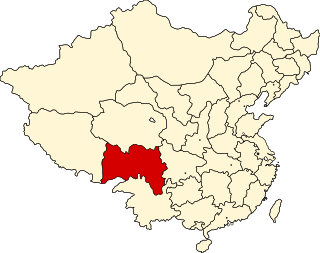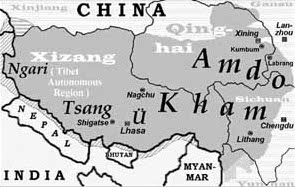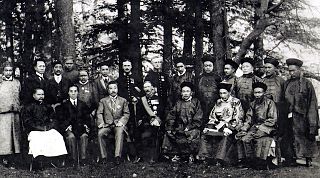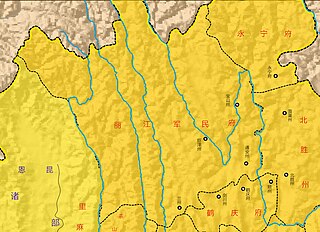
While the Tibetan plateau has been inhabited since pre-historic times, most of Tibet's history went unrecorded until the creation of Tibetan script in the 7th century. Tibetan texts refer to the kingdom of Zhangzhung as the precursor of later Tibetan kingdoms and the originators of the Bon religion. While mythical accounts of early rulers of the Yarlung Dynasty exist, historical accounts begin with the introduction of Tibetan script from the unified Tibetan Empire in the 7th century. Following the dissolution of the empire and a period of fragmentation in the 9th-10th centuries, a Buddhist revival in the 10th–12th centuries saw the development of three of the four major schools of Tibetan Buddhism.

Amdo is one of the three traditional Tibetan regions, the others being Ü-Tsang in the west and Dotoe also known as Kham in the east. Ngari in the north-west was incorporated into Ü-Tsang. The formal name of this Tibetan region/province is Domey in literatures. Historically, Amdo and Kham together were also called Do Kham on maps and manuscripts. Amdo encompasses a large area from the Machu to the Drichu (Yangtze). Amdo is mostly coterminous with China's present-day Qinghai province, but also includes small portions of Sichuan and Gansu provinces.

Kham is one of the three traditional Tibetan regions, the others being Domey also known as Amdo in the northeast, and Ü-Tsang in central Tibet. The official name of this Tibetan region/province is Dotoe. The original residents of Kham are called Khampas, and were governed locally by chieftains and monasteries. Kham covers a land area distributed in multiple province-level administrative divisions in present-day China, most of it in Tibet Autonomous Region and Sichuan, with smaller portions located within Qinghai and Yunnan.

Xikang was a nominal province formed by the Republic of China in 1939 on the initiative of prominent Sichuan warlord Liu Wenhui and retained by the early People's Republic of China. The former territory of Xikang is now divided between the Tibet Autonomous Region and Sichuan province.

Ü-Tsang is one of the three Tibetan regions, the others being Amdo in the north-east, and Kham in the east. The region of Ngari in the north-west was incorporated into Ü-Tsang after the Tibet–Ladakh–Mughal War. Geographically Ü-Tsang covered the south-central part of the Tibetan cultural area, including the Brahmaputra River watershed. The western districts surrounding and extending past Mount Kailash are included in Ngari, and much of the vast Changtang plateau to the north. The Himalayas defined Ü-Tsang's southern border. The present Tibet Autonomous Region corresponds approximately to Ü-Tsang and the western part of Kham.

Litang County is southwest of Garzê Tibetan Autonomous Prefecture, in Sichuan, China, in the traditional Tibetan region of Kham. It contains 7 towns and a population of more than 60,000 in 2020. Due to its elevation and mountainous terrain, the county has an alpine climate. Several famous Tibetan Buddhist figures were born here, including the 7th Dalai Lama, the 10th Dalai Lama, the 11th Tai Situpa, four of the Pabalas, as well as the 5th Jamyang Zhépa of Labrang Monastery. Düsum Khyenpa, 1st Karmapa Lama, returned here and built Kampo Nénang Monastery and Pangphuk Monastery. It also has strong connections with the eponymous hero of the Epic of King Gesar.
This is a list of topics related to Tibet.

Tusi, often translated as "headmen" or "chieftains", were hereditary tribal leaders recognized as imperial officials by the Yuan, Ming, and Qing dynasties of China, and the Later Lê and Nguyễn dynasties of Vietnam. They ruled certain ethnic minorities in central China, western China, southwestern China, and the Indochinese peninsula nominally on behalf of the central government. As succession to the Tusi position was hereditary, these regimes effectively formed numerous autonomous petty dynasties under the suzerainty of the central court. This arrangement is known as the Tusi System or the Native Chieftain System. It should not be confused with the Chinese tributary system or the Jimi system.

The Kashag was the governing council of Tibet during the rule of the Qing dynasty and post-Qing period until the 1950s. It was created in 1721, and set by Qianlong Emperor in 1751 for the Ganden Phodrang in the 13-Article Ordinance for the More Effective Governing of Tibet. In that year the Tibetan government was reorganized after the riots in Lhasa of the previous year. The civil administration was represented by the Council (Kashag) after the post of Desi was abolished by the Qing imperial court. The Qing imperial court wanted the 7th Dalai Lama to hold both religious and administrative rule, while strengthening the position of the High Commissioners.

The Simla Convention, officially the Convention Between Great Britain, China, and Tibet, was an ambiguous treaty concerning the status of Tibet negotiated by representatives of the Republic of China, Tibet and Great Britain in Simla in 1913 and 1914. The Simla Convention provided that Tibet would be divided into "Outer Tibet" and "Inner Tibet". Outer Tibet, which roughly corresponded to Ü-Tsang and western Kham, would "remain in the hands of the Tibetan Government at Lhasa under Chinese suzerainty", but China would not interfere in its administration. "Inner Tibet", roughly equivalent to Amdo and eastern Kham, would be under the jurisdiction of the Chinese government. The convention with its annexes also defined the boundary between Tibet and China proper and that between Tibet and British India.

Tibet was a de facto independent state in East Asia that lasted from the collapse of the Qing dynasty in 1912 until its annexation by the People's Republic of China in 1951.
Lingtsang was formerly one of the Kham region's five independent kingdoms of Tibet. The realm of Lingstang was incorporated into the People's Republic of China in 1950 following the Battle of Chamdo.

The Ganden Phodrang or Ganden Podrang was the Tibetan system of government established by the 5th Dalai Lama in 1642, when the Oirat lord Güshi Khan who founded the Khoshut Khanate conferred all spiritual and political power in Tibet to him in a ceremony in Shigatse. During the ceremony, the Dalai Lama "made a proclamation declaring that Lhasa would be the capital of Tibet and the government of would be known as Gaden Phodrang" which eventually became the seat of the Gelug school's leadership authority. The Dalai Lama chose the name of his monastic residence at Drepung Monastery for the new Tibetan government's name: Ganden (དགའ་ལྡན), the Tibetan name for Tushita heaven, which, according to Buddhist cosmology, is where the future Buddha Maitreya resides; and Phodrang (ཕོ་བྲང), a palace, hall, or dwelling. Lhasa's Red Fort again became the capital building of Tibet, and the Ganden Phodrang operated there and adjacent to the Potala Palace until 1959.

The Chiefdom of Lijiang was a Nakhi autonomous Tusi chiefdom that ruled Lijiang during Yuan, Ming and Qing dynasty.

Tibet under Qing rule refers to the Qing dynasty's rule over Tibet from 1720 to 1912. The Qing rulers incorporated Tibet into the empire along with other Inner Asia territories, although the actual extent of the Qing dynasty's control over Tibet during this period has been the subject of political debate. The Qing called Tibet a fanbu, fanbang or fanshu, which has usually been translated as "vassal", "vassal state", or "borderlands", along with areas like Xinjiang and Mongolia. Like the preceding Yuan dynasty, the Manchus of the Qing dynasty exerted military and administrative control over Tibet, while granting it a degree of political autonomy.
Gonpo Namgyal (1799–1865), also known as Bulungwa or Blind Warrior of Nyarong), was a Tibetan rebel leader from the Nyarong valley who unified the region, then most of Kham in a series of military campaigns from the late 1830s to the mid-1860s, warring also against Qing Dynasty forces and later the Tibetan government in Lhasa's Ganden Phodrang forces. While he was successful in defeating Qing forces, he was eventually captured and killed by Tibetan forces, putting an end to his rebel state in Nyarong and to Qing presence in Kham.
Chiefdom of Tsanlha, also known as Chiefdom of Lesser Jinchuan, was an autonomous Gyalrong chiefdom that ruled Lesser Jinchuan during Qing dynasty. The rulers of Tsanlha used the royal title Tsanlha Gyalpo.
Chiefdom of Bathang, or Chiefdom of Batang, was an autonomous Tusi chiefdom that ruled Bathang during the Qing dynasty period.
Chiefdom of Lithang, or Chiefdom of Litang, was an autonomous Tusi chiefdom that ruled Litang during the Qing dynasty period. Lithang, Bathang, Chakla and Derge were called the "Four Great Native Chiefdoms in Kham" (康区四大土司) by the Chinese.
The Gyalrong, also called the rGyalrong or Jiarong, are speakers of the Qiangic Gyalrong language who live in the southern part of Ngawa Tibetan and Qiang Autonomous Prefecture of Sichuan, China. They are also found in Danba County of Garze Prefecture. The word Gyalrong is an exo-ethnonym and loanword from the Tibetan word rGyal-mo tsha-wa rong.











